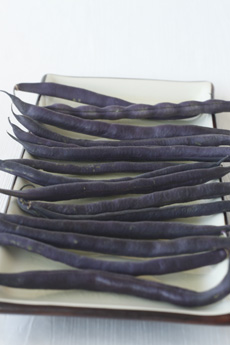TIP OF THE DAY: Purple Green Beans & Other Farmers Market Finds
|
Food can be fun; and unexpected food finds are especially fun.
Take these purple green beans, known as Royalty Purple Pods. While they were introduced in 1957, have you ever seen them? The trick is to arrive at farmers markets early in the day, before the unusual veggies sell out. While the skin of the Royalty Purple Pod is purple, there’s a green bean underneath. The purple skin turns green when cooked. To retain the color, you can butter baste them in a pan. If you boil them, a pinch of baking soda in the water will help a bit. Losing the lovely purple color is no fun. So we like to serve these unusual green beans raw: |
 These green beans are purple. Photo by Elvira Kalviste | THE NIBBLE. |
|
|
Generally, purple green beans (and yellow green beans) have the same taste and texture as conventional green green beans. But how can you resist a purple green bean? Even people who eschew green beans can be tempted to take a bite. So today’s tip is: Look for something new and different at your farmers market. Make your goal a weekly fun food discovery. Then tell us what you found, and how you served it. FOOD TRIVIA: What’s the difference between green beans and string beans? The French call them haricots vert (green beans), the Brits call them French beans, and Americans call them green beans or string beans. The term “string bean” refers to the string that ran up the seam of the bean. It had to be removed before cooking. The first “stringless” bean was bred in 1894 by Calvin Keeney, in Le Roy, New York, a town in western New York state that is also the is the birthplace of Jell-O. Today, just about every bean sold commercially is a stringless bean; but the original name has been passed down through generations and is a legacy. |
||


